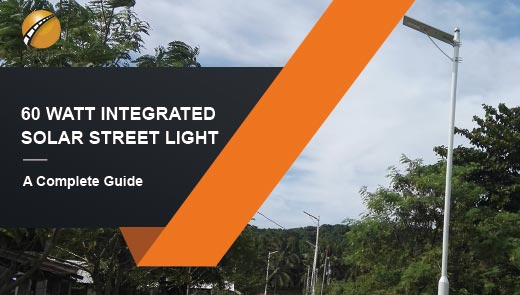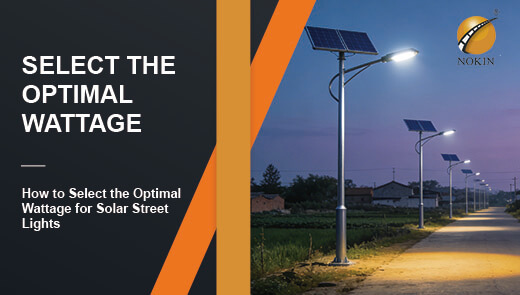How to Choose Solar Street Lights for the Pathway Project?
Whether it is the leisure walkways within the community, the landscape paths in the park, or the passageways on campus, the core of the pathway project is to provide pedestrians with a safe and comfortable passage environment. As the "nighttime eyes" of pathway, solar street lights not only affect pedestrians' sense of security and experience, but also directly relate to the long-term operation and maintenance costs of the project.
Many project managers have fallen into the trap of "choosing cheap lights to save costs", but in the end, they have received safety complaints due to insufficient brightness and frequently replaced lights because of poor materials, which has instead increased their additional expenses.
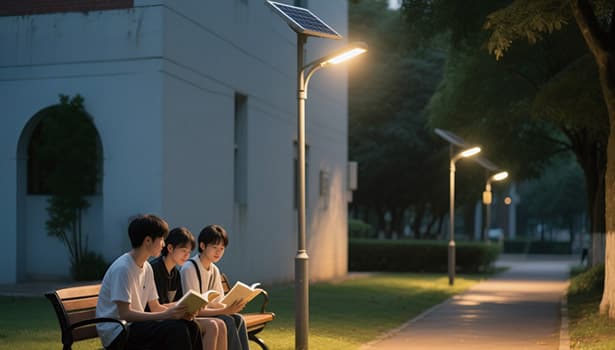
Why Not Choose Solar Street Lights for the Pathway Based on "Feeling"?
Pathway is different from main roads. Its core scenario is "pedestrians passing through at close range", which determines that the selection of solar street lights has its particularity - it neither needs to pursue extremely high brightness like main road street lights, nor should it leave safety hazards due to insufficient brightness. It is necessary to adapt to the complex outdoor weather while also taking into account the limited installation space.
3 Demands of the Pathway Project
The selection of solar street lights by Pathway essentially aims to balance three major demands:
- Safety: Pedestrians should clearly see potholes, steps and obstacles on the road surface to avoid tripping at night.
- Aesthetic appeal: The style of the lighting fixtures should be in harmony with the surrounding environment (such as community greenery and park landscapes), without spoiling the overall beauty.
- Economy: Although the initial investment in solar street lights is slightly higher, high-quality products can last for 5 to 8 years without replacement, while inferior products require maintenance within 1 to 2 years, resulting in even higher long-term costs.
4 Hidden Risks of Choosing the Wrong Solar Street Light
If you choose solar street lights merely based on "price" or "appearance", the following problems are very likely to occur:
- Insufficient brightness: For instance, if a 100-lumen lightis used to illuminate a pedestrian path with high foot traffic, pedestrians at night cannot see the road clearly, increasing the risk of falls.
- Battery life failure: The light does not light up after two consecutive rainy days, requiring frequent manual charging, which goes against the "maintenance-free" advantage of solar energy.
- Rapid damage: Insufficient IP rating, water ingress and short circuit during rainy days, or material not corrosion-resistant, rusting and shell cracking occur within one year.
- Installation rework: The lights are too large in size to be installed on narrow walkways, or additional wiring is required, increasing labor costs.
Therefore, the selection of solar street lights for the pathway project must follow the logic of "scientific assessment and step-by-step verification".
Accurately Assess the Lighting Requirements of the Pathway
Many people mistakenly believe that "the higher the brightness of solar street lights, the better", but for pathway, excessive lighting not only wastes electricity but may also affect pedestrians' vision due to the dazzling strong light. The correct approach is to first clarify your own needs and then match the corresponding parameters.
Determine the Brightness According to the "Density of People Flow"
Lumen is a unit for measuring luminous flux and directly determines the lighting intensity of solar street lights. Pathways with different densities of human flow have significantly different requirements for brightness:
Medium-flow walkways: Such as the main walkways in residential areas and the core passageways in parks, where a large number of people pass through each day, require a brightness of around 450 lumens. This brightness can cover an area with a diameter of approximately 10 feet (about 3 meters), allowing pedestrians to clearly see the details of the road surface within 3 meters.
Low-traffic trails: Such as the paths along the edges of residential areas and secluded paths in parks, where there are few visitors each day, 100 to 200 lumens are sufficient to meet the needs. For instance, on the evening walking path, the warm light of 200 lumens can not only provide basic lighting but also create a relaxing atmosphere.
Special Scenarios: If there are elderly activity areas or children's play areas beside the trail, it is recommended to appropriately increase the brightness to 300-350 lumens to prevent accidents caused by low visual sensitivity of the elderly and children.
Calculate the Coverage Area Based on the "Walkway Size"
The lighting coverage area needs to be calculated in combination with the width and length of the pathway, with the core being "no blind spots and no overlapping waste".
Take the common "1-meter-wide and 20-meter-long" community walkway as an example:
If a single light with a coverage radius of 3 meters (corresponding to 450 lumens) is chosen, the recommended installation spacing for solar street lights is 5 to 6 meters (1.8 to 2 times the coverage radius). For a 20-meter-long walkway, 4 lights need to be installed to cover the entire path without any blind spots.
If the width of the walkway reaches 2 meters (such as the main walkway in a park), lights with a coverage radius of 4 meters should be selected, or the installation spacing should be reduced to 4-5 meters to avoid lighting dead zones on both sides of the edge.
Determine the Functional Orientation According to the "Lighting Purpose"
The lighting purposes of different pathways vary. When choosing solar street lights, the corresponding functions should be emphasized
- Safety-oriented: For instance, the walkways used by students after evening self-study on campus and the walkways near the roads in residential areas, the core is to "clearly see the road surface and warn of risks". Cold white light with a luminance of 300 to 450 lumens (5000K-6000K) should be selected. Cold white light has strong penetrating power and enables pedestrians to quickly identify road obstacles.
- Atmosphere-oriented: Such as the cherry blossom walkway in the park and the landscape walkway in the community, the core is to "create a comfortable atmosphere". It is recommended to choose warm white light of 100 to 200 lumens (2700K-3000K). The warm light is soft and not dazzling, and can be matched with the surrounding green plants and landscapes.
- Security + multi-functional type: Such as walkways near parking lots and community walkways with complex foot traffic, safety and energy conservation need to be taken into account. You can choose the combination of "300 lumens base brightness + motion sensor". When someone approaches, the brightness increases to 450 lumens, and when no one is around, it drops to 150 lumens, which not only ensures safety but also saves power.
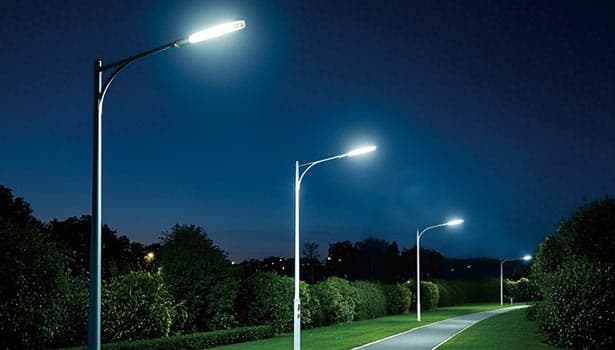
Evaluate the Components of Solar Street Lights
The core of solar street lights is "generating electricity during the day and lighting up at night", and the power generation efficiency depends on the solar panels, while the power storage capacity depends on the batteries. These two components directly determine whether the street light can work normally on rainy days.
Solar panel
The materials of solar panels are divided into three types: monocrystalline silicon, polycrystalline silicon, and thin-film. For the pathway project, monocrystalline silicon is the best choice.
The advantages of monocrystalline silicon: Its light conversion efficiency can reach 18% to 23%, which is 3% to 5% higher than that of polycrystalline silicon. This means that under the same area, monocrystalline silicon panels can generate more electricity, especially suitable for the "limited installation space" scenarios of pathway (such as only narrow green belts beside the walkway, making it impossible to install large-area solar panels).
- Cloudy weather performance: Monocrystalline silicon plates are more sensitive to weak light and can continuously generate electricity even on cloudy days or in the evening. For instance, in rainy regions, monocrystalline silicon panels can achieve a power generation efficiency of over 50% on cloudy days, while polycrystalline silicon panels may only reach 30%.
- Misconception Reminder: Do not choose "low-priced polycrystalline silicon boards". Although they are initially cheaper, their power generation efficiency is low. Larger boards need to be installed, which actually occupies more space on the walkway. Moreover, they are prone to power outages on rainy days.
Battery
The battery is the "energy warehouse" of solar street lights. Insufficient capacity or poor material quality will lead to the failure of battery life. Two key points need to be paid attention to when making a choice:
- Material-first lithium batteries: Compared with traditional lead-acid batteries, lithium batteries have three major advantages: long lifespan (5-8 years vs. 2-3 years), small size (under the same capacity, the volume of lithium batteries is only 1/3 of that of lead-acid batteries, suitable for compact installation on walkways), and no memory effect (can be charged and used at any time, no need to recharge after discharging completely).
- Capacity is calculated based on "rainy days" : Battery capacity is measured in "mAh" (milliampere-hours), and the calculation logic is "meeting the local longest night duration + at least 3 days of rainy backup".
Battery life
Battery life refers to the number of days that a solar street light can be continuously lit after a battery is fully charged. For the pathway project, battery life needs to meet two requirements:
- Maximum night coverage: The night duration in winter can reach up to 10 hours, and in summer it is approximately 7 hours. The battery must be capable of supporting full-power lighting for a single night.
- Reserve a backup for rainy days: It supports at least 3 consecutive days of rainy weather. Even if there is no sun for 3 days, the solar street lightcan still light up normally. For instance, if a solar street lightis marked with "72-hour battery life", it means that it can stay lit continuously for 3 days after a full charge, making it suitable for rainy areas. If marked as "48-hour battery life", it is more suitable for dry areas.
Check the Durability and Weather Resistance of Solar Street Lights
The solar street lights of pathway are exposed to the outdoors for a long time, with wind, rain and sun being the norm. Their durability directly determines their service life.
The IP protection level of solar street lights
The IP rating is a standard for measuring the dust and water resistance of lights, formatted as "IPXX". The first X represents the dust resistance rating, and the second X represents the water resistance rating. For pathway street lights, they must meet IP65 or above:
- IP65 Interpretation: "6" represents complete dust-proof (dust cannot enter the interior of the light), and "5" represents water-proof (water from any direction will not affect the operation of the light). This means that even in heavy rain, when rainwater flows down the lightbody or when a water sprinkler passes by and splashes water, it will not cause a short circuit.
- Risk of lower than IP65: If IP54 lights (dust rating 5, water rating 4) are selected, dust can easily enter and accumulate inside, affecting the heat dissipation of LED beads, and brightness attenuation may occur within one year. If water splashes into the joints of the lights on rainy days, it may also cause water to enter and short circuit, leading to the scrapping of the lights.
- Special scene upgrade: If the pathway is close to the seaside (such as the coastal walkways in coastal cities), it is recommended to choose IP67 lights. The "7" indicates that they can be immersed in water for a short time (30 minutes in a depth of 1 meter), and can resist the salt corrosion caused by sea breeze and typhoons and heavy rain.
The material of solar street lights
The materials of the light housing and brackets of solar street lights need to be adapted to the local climate
- Rainy/Coastal areas: Prioritize stainless steel materials (such as 304 stainless steel), which have strong rust resistance and will not rust even after long-term exposure to rain. Secondly, aluminum alloy material can be selected (the surface needs to be oxidized), which is light in weight, corrosion-resistant, and has a cost 10%-15% lower than that of stainless steel.
- Dry/inland areas: Durable plastic materials (such as ABS engineering plastic) can be selected, which are low-cost, lightweight, and resistant to temperature differences (can operate normally from -30℃ to 60℃), making them suitable for dry regions.
- Avoid inferior materials: Do not choose "iron sheet with plastic coating" lights. Although they are cheap, the paint will peel off and rust within 1-2 years, and the brackets will need to be replaced frequently in the later stage, increasing the operation and maintenance costs.
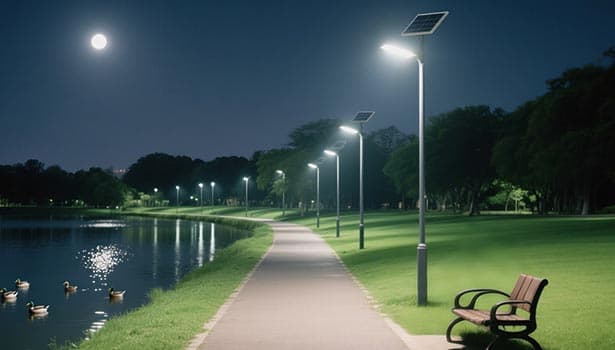
Solar Street Lights Adapted to Pathway Are "Small But Beautiful"
The lighting fixtures of pathway do not need to be "high-end", but they should be "small and beautiful" - compact in size, flexible in installation and in harmony with the environment.
LED Light Beads
LED beads are the "light-emitting core" of solar street lights. When choosing them, both brightness and color temperature should be taken into consideration.
- Brightness matching requirement: If the requirement is "safety-oriented", select 450-lumen LED beads; If it is "ambient orientation", 150 lumens is sufficient to avoid excessive brightness.
- Color temperature adaptation scenarios: Color temperature is measured in "K" (Kelvin), and different color temperatures are suitable for different scenarios:
Warm white light (2700K-3000K) : The light is slightly yellowish, soft and not dazzling, making it suitable for park landscape walkways and community leisure walkways.
Neutral light (4000K-4500K) : The light is close to natural light and is suitable for campus walkways and those around office areas.
Cold white light (5000K-6000K) : The light is slightly white and has strong penetrating power, making it suitable for safety-oriented walkways near roads and parking lots.
Light Structure
Solar street lights are classified into integrated and semi-integrated types based on their structure, and both are suitable for pathways of different scales.
- Integrated solar street light: Suitable for small areas and simple trails, such as short trails within 100 meters in residential areas and branch paths in parks. The advantages are easy installation (only one bracket needs to be fixed), compact size (not taking up too much space), and low cost.
- Semi-integrated solar street light: Suitable for large areas and high-demand trails, such as main trails over 1 kilometer in parks and sightseeing trails in scenic spots. The advantages are flexible adjustment (solar panels can be installed on the light posts and trees beside the walkway, and the light bodies can be installed at the edge of the walkway) and high power generation efficiency (larger sizes of solar panels can be selected).
Multi-Dimensional Comparative Verification
The prerequisite for choosing the right product is to select the right supplier. Many project managers choose the wrong supplier due to "seeking cheapness", and it is difficult for them to protect their rights later.
Cost Comparison
The cost of solar street lights should be calculated based on the "general account" rather than just the unit price.
- Low-price trap identification: If a supplier's quote is only 50% of the market average price, be cautious of configuration downgrades: for instance, using polycrystalline silicon boards instead of monocrystalline silicon boards, lead-acid batteries instead of lithium batteries, or inferior LED beads. This type of product may seem cheap, but it needs to be repaired or replaced every 1 to 2 years. In fact, its long-term cost is 30% higher than that of high-quality products.
- Reasonable cost range: Integrated solar street lights with 450 lumens, IP65 and lithium batteries usually have a unit price of 300 to 500 yuan per light. The unit price of semi-integrated street lights (including independent solar panels) is between 600 and 800 yuan per light. Caution is needed if the price is below this range.
Warranty and After-sales Service
The warranty policy is the supplier's "commitment" to product quality, and two key points need to be focused on:
- Warranty period: The entire machine is warranted for at least one year, and the core components (solar panels, batteries, LED beads) are warranted for at least two years.
- After-sales response: Confirm whether the supplier of solar street lights provides timely after-sales response and can promptly solve problems that arise during use.
Manufacturer's Reputation
When choosing a solar street light supplier, the reputation needs to be verified through two dimensions:
- Past cases: Request the supplier to provide cases of similar pathway projects and review on-site photos or videos to confirm the actual effect;
- Industry qualifications: Check whether the supplier has "CE certification" (EU safety certification), "ROHS Certification" (environmental protection certification), and "CQC Certification" (China Quality Certification). These qualifications are the foundation for the product to meet safety and environmental protection standards.
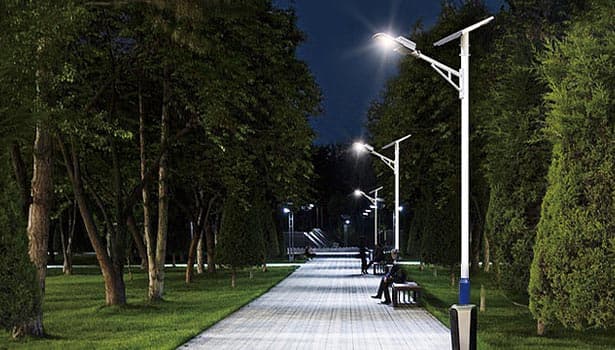
Consider the Installation and Additional Functions of Solar Street Lights
Even if the right product is selected, if the installation is complex or the functions are redundant, it will still affect the project effect.
Installation Compatibility
pathway projects usually have limited space, so the installation difficulty should be minimized as much as possible
- No-wiring design: Integrated solar street lights do not require additional wiring. Just fix the bracket and connect the battery. For semi-integrated street lights, it is necessary to confirm whether the wire length is sufficient (it is recommended to choose products with a wire length of more than 5 meters to match the distance between the solar panel and the lightbody).
- Complete accessories: High-quality suppliers will provide a full set of installation accessories (brackets, screws, expansion bolts, instruction manuals), avoiding additional purchases later.
- Volume adaptation: For narrow walkways (with a width of less than 1 meter), small-sized lights should be selected, with a lightbody diameter not exceeding 15 centimeters, to avoid occupying passage space. For wide walkways, large-sized lights can be appropriately selected to enhance their aesthetic appeal.
Intelligent Function
Intelligent functions can enhance the practicality of street lights, but they need to be "selected as needed" to avoid redundant functions and increased costs.
- Light-controlled switch: No manual operation is required. During the day, the solar panel automatically charges when it detects light, and at night, it automatically lights up when the light dims, fully achieving "maintenance-free" operation.
- Motion sensor: Suitable for low-traffic trails. When someone approaches (detection distance 3-5 meters), the brightness increases from 150 lumens to 450 lumens. When no one is around, it returns to low brightness, which can save more than 30% of battery power.
- Remote control: If the scale of the pathway is small (such as short walkways in a community), the practicality of remote control functions (such as adjusting brightness and checking battery level through an APP) is low, which may instead increase costs. If the scale is large (such as long trails in scenic spots), products with remote control can be chosen to facilitate unified management.
The selection of solar street lights for the pathway project is not about "choosing the most expensive one", but rather "choosing the most suitable one". Through scientific assessment and step-by-step verification, it can not only ensure pedestrian safety and enhance the aesthetic appeal of the environment, but also reduce long-term operation and maintenance costs, achieving the "maximization of cost performance" for the project.

